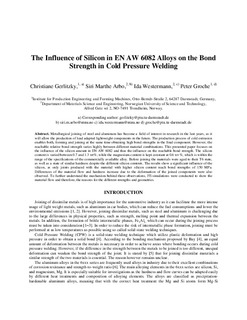The influence of silicon in EN AW 6082 alloys on the bond strength in cold pressure welding
Journal article, Peer reviewed
Accepted version

Åpne
Permanent lenke
http://hdl.handle.net/11250/2636580Utgivelsesdato
2019Metadata
Vis full innførselSamlinger
- Institutt for materialteknologi [2499]
- Publikasjoner fra CRIStin - NTNU [37236]
Sammendrag
Metallurgical joining of steel and aluminum has become a field of interest in research in the last years, as it will allow the production of load adapted lightweight components in the future. The production process of cold extrusion enables both, forming and joining at the same time obtaining high bond strengths in the final component. However, the reachable relative bond strength varies highly between different material combinations. This presented paper focuses on the influence of the silicon amount in EN AW 6082 and thus the influence on the reachable bond strength. The silicon content is varied between 0.7 and 1.3 wt%, while the magnesium content is kept constant at 0.6 wt %, which is within the range of the specifications of the commercially available alloy. Before joining the materials were aged to their T6 state, as well as a state of similar hardness despite the different silicon contents. The results show a significant influence of the silicon, as only joints produced with the material with higher silicon content reach bond strengths of 150 MPa. Differences of the material flow and hardness increase due to the deformation of the joined components were also observed. To further understand the mechanism behind these observations, FE-simulations were conducted to show the material flow and therefore, the reasons for the different strengths and geometries.